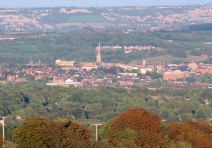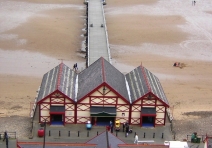WORLD TRAVEL NEWS ARTICLE
THE UNITED KINGDOM
'The Suffolk Coast'
A mild autumn day on the Suffolk coast. I’m looking out over the sea in Aldeburgh, standing on stonework half buried in turf. This is all that remains of Slaughden, once a prosperous village on Aldeburgh’s southern flank.
Southwold's famous pier
Everywhere along the Suffolk coast you can witness the sea’s encroachment on the land. In East Anglia, land over 200 feet is considered ‘mountainous’ and on the coast the sea seems to invade every available nook and cranny, nibbling away at the land with a relentless intensity which even King Cnut would have done well to arrest. Flat, but not without interest. A landscape which might be a headache for coastal environmentalists is a delight for walkers. Wildlife, especially those of the winged kind, thrives.
Brightly coloured beach huts at Southwold
Between the river Ore and Southwold is a stretch of coastline that is unique in Britain. This is the Suffolk of wide beaches, deserted estuaries and horizons stretching to infinity. Here you can soak up the atmosphere in little resorts where the emphasis is more fine dining than bingo and candyfloss …or, out on the marshes, be as alone as you would be in a remote corner of the Scottish highlands.
From Slaughden I followed a path across the Aldeburgh marshes, happily losing myself for a couple of hours in a world of reed beds and derelict buildings – a reminder there was once thriving industry here.
A flock of Canada geese flew overhead in the general direction of one of East Anglia’s most famous landmarks, Benjamin Britten’s Maltings concert hall, home every June to one of the world’s most famous classical music events - the Aldeburgh Festival.
Moments later a friendly dog walker stopped for a chat and then directed me along the path which took me straight back to Aldeburgh. “Don’t forget to buy some fish from the stalls on the beach to take home,” she counselled.
Benjamin Britten's former home
Aldeburgh is little changed from the days when Benjamin Britten lived there after World War 2. It’s still a sleepy backwater – a situation which is partly explained by the fact that you have to specifically drive to it, rather than drive through it. The beach may be shingle, but the town packs oodles of character into its quaint streets – neat pastel coloured cottages, the 16th century Moot Hall, which used to be in the middle of town but now, thanks to the coastal erosion, stands within a stone’s throw of the sea.
The Moot Hall
Closeby I discovered the humble wooden stalls selling the fish my dog walking friend had recommended – freshly caught skate, bass, flounder and, of course, clams and lobster all on sale at prices considerably less than you’d find in your local supermarket. Fish is very much the food of choice.
Aldeburgh’s fish and chip shop, run by the same family since 1967, is a stylish establishment guaranteed to put most of its peers in the shade.
But for a real fish treat take yourself off to the Butley Oysterage in the pretty stone and thatched cottage village of the same name from where, in the 12th century, Eleanor of Aquitaine set forth to ransom her son Richard the Lionheart. In this simply furnished but immaculate establishment I enjoyed oyster soup with brown Saxon bread and a delicious lemon sole with a prawn Vermouth sauce, new potatoes and salad – good value, I thought, at just over £20.
This is an area that prides itself on fine dining – a fact that hasn’t gone unnoticed by dedicated ‘foodies.’ Good food comes not just in hotels and restaurants, but country pubs like the Queen’s Head at Bramfield. Here, in a relaxed setting of soft light and exposed beams you can enjoy hearty delights such as angels on horseback (oysters wrapped in smoked bacon, grilled and served on toast), slow roasted Gressingham duck, and moules marinière with skinny fries and garlic mayonnaise. This pub-restaurant uses locally sourced ingredients wherever it can.
Still on the gourmet tack, Suffolk is home to numerous vineyards. At Shawsgate vineyard, which is little more than a mile from the imposing walls of Framlingham Castle, where Henry VIII’s daughter Mary Tudor rallied her supporters, you can enjoy a picnic on the 13 acre site and afterwards taste the establishment’s seven different wines.
North of Aldeburgh, the Suffolk coast twists and turns past the eccentric little resort of Thorpeness, with its boating lake and fairytale House in the Clouds, past the RSPB’s Minsmere nature reserve and the ‘lost’ city of Dunwich, where Christianity first established itself in East Anglia before surrendering to the sea, all the way to Southwold.
The ‘lost’ city of Dunwich
I took time out in Southwold, busy with visitors on that warm autumn day. Southwold packs a surprising amount of interest into a relatively small area – buildings of significance, the wide open spaces of the Greens, formed after a fire in 1659, quaint shops and hidden alleyways and an award-winning pier. It was on the pier, at a neat café, that I enjoyed afternoon tea - a commodity which comes second only in the town’s affections to beer (the town is home to the Adnams brewery concern, the largest in East Anglia).
Adnam's Brewery in Southwold
When it came to finding a place to stay, I opted for the Brudenell Hotel in Aldeburgh, from where you can watch the sun rise over the sea in the morning and set over the marshes in the evening. The Brudenell has recently been refurbished and its light, airy rooms accurately reflect Aldeburgh itself and is all you could hope for in a British resort hotel. Its rooms, some looking out of the sea and others over the marshes, are large and extremely comfortable and its restaurant offers food as good as you will find on the Suffolk coast.
My two days had passed all too quickly, but on my way back to London I had one more mission – to see Sutton Hoo. It was here, on a 255-acre site overlooking the river Deben, a local archaeologist Basil Brown discovered in a burial mound the remains of an Anglo Saxon king and his possessions. The story is told in Sutton Hoo’s exhibition centre, where there’s a full-size reconstruction of the burial chamber and replica treasures.

A Sutton Hoo warrior's helmet
The setting is sublime. As I left the sun was casting an orange glow over the Deben estuary – and a fitting note on which to end an all-too-brief stay on the Suffolk coast.
For more detailed information visit:
Brudenell Hotel, Aldeburgh www.brudenellhotel.co.uk
Sutton Hoo www.nationaltrust.co.uk
East of England Tourism www.visiteastofengland.com
You may also like to read

UNITED KINGDOM - TASTING OPPORTUNITIES
A street where visitors can sample beer, tea, coffee and Italian wines, sounded too good to be true – Tour-smart investigated.

UNITED KINGDOM - JET BLACK & BEAUTIFUL
Tour-smart's Editor takes us to the 'Dark Side' and finds it shiny and lustrous.

Comments